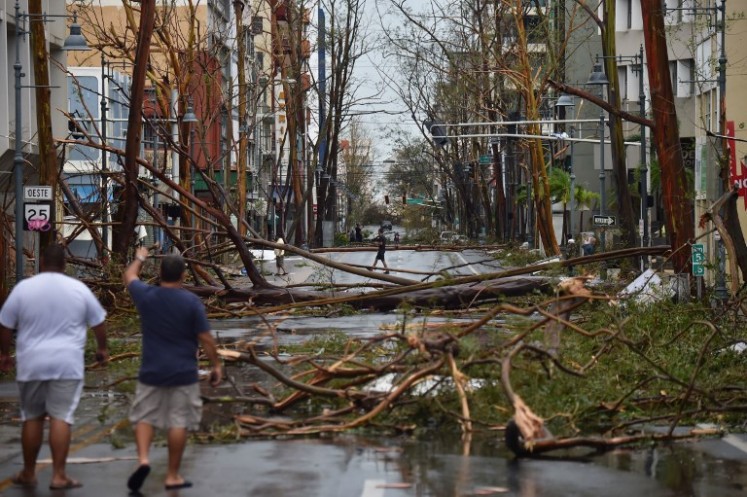Popular Reads
Top Results
Can't find what you're looking for?
View all search resultsPopular Reads
Top Results
Can't find what you're looking for?
View all search resultsOh no, here we go again: Atlantic hurricane season
The Atlantic hurricanes are likely to hit Florida and the Caribbean.
Change text size
Gift Premium Articles
to Anyone
L
isten closely and you'll hear the groan of collective dread in Florida and the Caribbean: yes, it's already hurricane season again.
Both places were pummeled last year by monster storms and both -- in the case of Florida it was the plume of once-lovely coral islands known as the Florida Keys -- are still struggling to rebuild.
"If a storm comes through, we're screwed," said Cindy P., a 48-year-old waitress who lives in the Keys and explained houses in the area weren't yet prepared.
In the Caribbean, hit by two hurricanes in rapid-fire succession in September, the pain and shock of all that is still quite raw. People can't seem to catch their breath.
This week alone, a new study concluded that in Puerto Rico, 4,645 people died as a result of Hurricane Maria. The official toll in the US territory is 64 dead. Against that jittery and shell-shocked backdrop, the new hurricane season started Friday.
Not even waiting for it, a plucky subtropical storm named Alberto caused flooding this week along the US East Coast. Authorities in Florida say they have learned their lesson and are promising better telecoms and management of relief funds.
In Puerto Rico, the government is recommending that people amass provisions for 10 days, rather than just three as had been the case until now. Much of the territory went months without water or power after Hurricane Maria.
But like that waitress Cyndi, people do not feel ready.
The Florida Keys are an archipelago that arcs out 180 kilometers southwest from the southern tip of the state and are connected by 42 bridges. In this tourist destination, debris still clogs many canals. In working class neighborhoods you see many destroyed homes and some people living in tents on their front lawns.
"We take care of people up to a point. However, there reaches a point where they have to start taking care of themselves again," said Martin Senterfitt, emergency management director of Monroe County, which includes the keys.
Latent problems
Hurricanes Irma and Maria accentuated problems that were already latent in areas that they blasted with storm surges and more-than-200 kilometer per hour winds. For instance, of the 55,000 homes in the keys, more than 1,000 were reduced to their foundations and 3,000 suffered major damage. Also lost were 1,044 mobile homes and pre-fab houses. More expensive homes, especially those in the last island, Key West, were spared by Irma, which scored a direct hit on the islands on Sept. 10.
It was devastating for the working class: restaurant workers, landscapers, construction people and other low earners cannot find affordable housing. So they packed up and shipped out, leaving many employers without a workforce. Many businesses have dusty "Help Wanted" signs in their front windows.
"We have major demand and there's no supply," Diane Eliopoulus, marketing manager at a Hard Rock Cafe in Key West, said at a board of commissioners meeting at which she said she had lost many employees.
"I get a lot of applicants, not anyone from this area. I say to them, 'would you mind looking at the housing market before making a decision to come?' I never get a call back," she added.
In Puerto Rico, Hurricane Maria laid bare the decrepit state of the territory's electrical grid. Eight months after the storm hit on Sept. 20, there are still regular blackouts. And some 60,000 customers are still without power in the US possession of 3.3 million people, which was already saddled with a gargantuan debt crisis.
That extended lack of electricity killed older and sick people who depended on respirators or insulin, caused unemployment to rise and prompted nearly 200,000 people to leave the islands.
Destroyed: Men walk damaged trees after the passage of Hurricane Maria, in San Juan, Puerto Rico, on Sept. 20, 2017. (AFP/Hector Retamal)Lessons learned
Governor Ricardo Rossello also says he has learned his lesson. The government filled warehouses with spare parts and prepared agreements that will allow for immediate assistance if the electrical grid collapses again.
"If we once again have to wait 50 days for the US Corps of Engineers to reach Puerto Rico, then we have not learned anything," Rossello said this week as he announced the plan.
In Barbuda, a tiny island in the Caribbean, Irma blew in like a bomb, destroying pretty much everything. It is still recovering from damage estimated at more than $200 million. Just about everybody fled.
To this day, only 500 of the original 1,800 inhabitants have come back.











